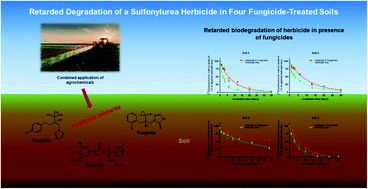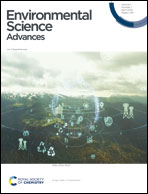Decelerated degradation of a sulfonylurea herbicide in four fungicide-treated soils†
Abstract
Soil microbial communities which are essential for soil ecosystems can be disturbed by a manifold of environmental variables, including pesticides. Among others, fungicides are frequently applied as effective crop protection chemicals in modern agriculture. Due to their wide killing and inhibitory capabilities, broad-spectrum fungicides play a dominant role in alteration of the soil microflora. Alteration of the soil microbial composition due to the presence of e.g., fungicides affects the environmental fate of co-existing chemicals. Ergo, the degradation rate of such compounds can be inhibited and their dissipation half-life in the environment can be prolonged. Nonetheless, current international guidelines for testing of chemicals are designed for the examination and risk assessment of a single chemical compound in their respective test system. While mixtures have been thoroughly studied concerning their agronomic efficacy, possible cumulative or synergistic effects and interactions between individual mixed compounds in the environment, and indirect side-effects such as alteration of microbial communities in soil, water and sediment were only rarely investigated. Therefore, we investigated the potential environmental impact of tank mixtures containing broad spectrum fungicides tebuconazole and prothioconazole on the degradation of the herbicide iodosulfuron-methyl-sodium in US American and German soils under controlled laboratory conditions. We showed that the biodegradation of the herbicide iodosulfuron-methyl-sodium in four different soils is decelerated in the presence of the fungicides tebuconazole and prothioconazole. This effect was observed from the inhibited biotic transformation of the herbicide into its main soil metabolite. Except for one soil, the adverse fungicidal effect was transient and mitigated towards the end of the respective incubation periods. Half-lives (DT50) and DT90 values of the herbicide in the four fungicide-treated soils increased 1.5 to 2.9-fold and 1.3 to 2.2-fold, respectively when compared to those in the untreated control soils.

- This article is part of the themed collections: Topic Collection: Agriculture, Soil and Plants and Environmental Science: Advances – Editorial and Advisory Board Member Publications


 Please wait while we load your content...
Please wait while we load your content...